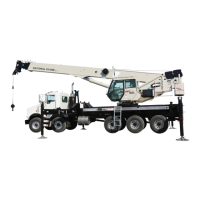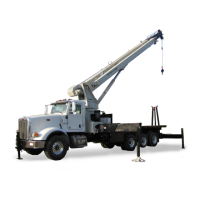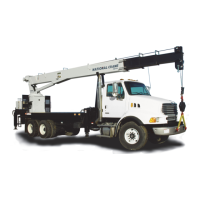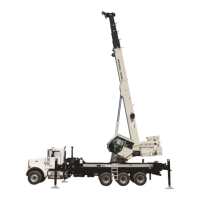LUBRICATION PROCEDURE AND CHARTS OPERATOR MANUAL NBT50
5-10 Published 03-23-2018 Control # 243-14
• have a high film strength.
• resistant to oxidation.
Before applying lubrication, accumulations of dirt or other
abrasive material should be removed from the rope. Clean
with a stiff wire brush and solvent, compressed air, or live
steam. Lubricate the rope immediately after the rope is
cleaned. Techniques that can be used include:
• bath
• dripping
• pouring
• swabbing
• painting
• pressure spray
Whenever possible, the lubricant should be applied at the
top of a bend in the rope, because at that point the strands
are spread by bending and are more easily penetrated.
There should be no load on the rope while it is being
lubricated. The service life of wire rope is directly
proportional to the effectiveness of the method used and
amount of lubricant that reaches the working parts of the
rope.
CARWELL
®
RUST INHIBITOR
Protecting Cranes From Rusting
Manitowoc Crane Group's cranes are manufactured to high
quality standards, including the type of paint finish
demanded by today's industry. In partnership with our paint
supplier, we are also doing our part to help prevent
premature corrosion of cranes.
National cranes will be treated with a rust inhibitor called
Carwell
T32-CP-90. While a rust inhibitor cannot guarantee
that a machine will never rust, this product will help protect
against corrosion on National cranes that are treated with
this product.
Carwell is a treatment, not a coating. It contains no silicones,
solvents, CFCs or anything that would be classified as
hazardous under OSHA Regulation 29CFR-19-10.1200. The
product is a liquid blend of petroleum derivatives, rust
inhibitors, water-repelling and water-displacing agents.
Special equipment is used to spray a light film onto the entire
undercarriage and various other areas of each new crane
prior to shipment. When applied the product has a red tint to
allow applicators to view coverage during application. This
red tint will turn clear on its own within approximately 24
hours after application.
Once applied, treatment can appear to leave a slightly “oily”
residue on painted surfaces and until the red tinting fades
could initially be mistaken for a hydraulic oil leak. While the
product is not harmful to painted surfaces, glass, plastic or
rubber, it must be removed using standard steam-cleaning
techniques.
This treatment works in various ways: (1) it eliminates the
moisture containing salt, dirt and other pollutants by lifting
and removing them from the metal surface; (2) the film
creates a barrier to repel further moisture from coming in
contact with the metal; and (3) it penetrates crevices.
In addition to the factory-applied treatment, National crane
owners must provide proper maintenance and care to help
ensure long-term protection of their crane against corrosion.
This procedure provides information and guidelines to help
maintain the paint finish on National cranes.
The most common causes of corrosion include the following:
• Road salts, chemicals, dirt, and moisture trapped in the
hard-to-reach areas;
• Chipping or wear of paint, caused by minor incidents or
moving components;
• Damage caused by personal abuse, such as using the
decks to transport rigging gear, tools, or cribbing; and
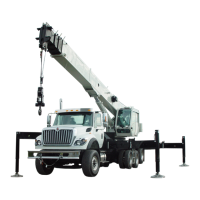
